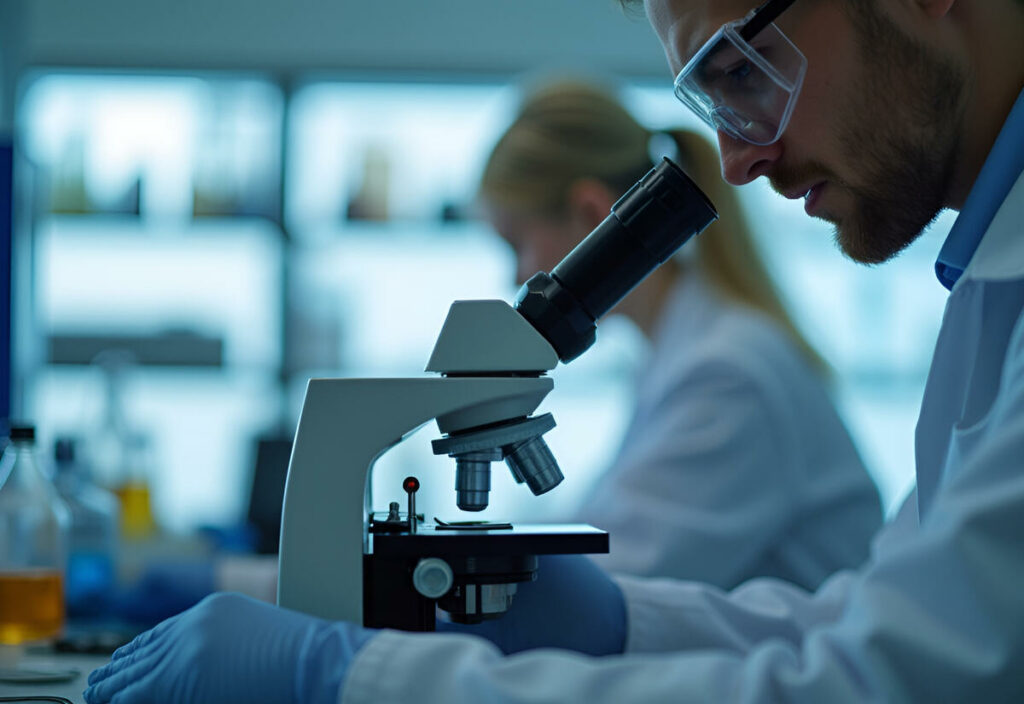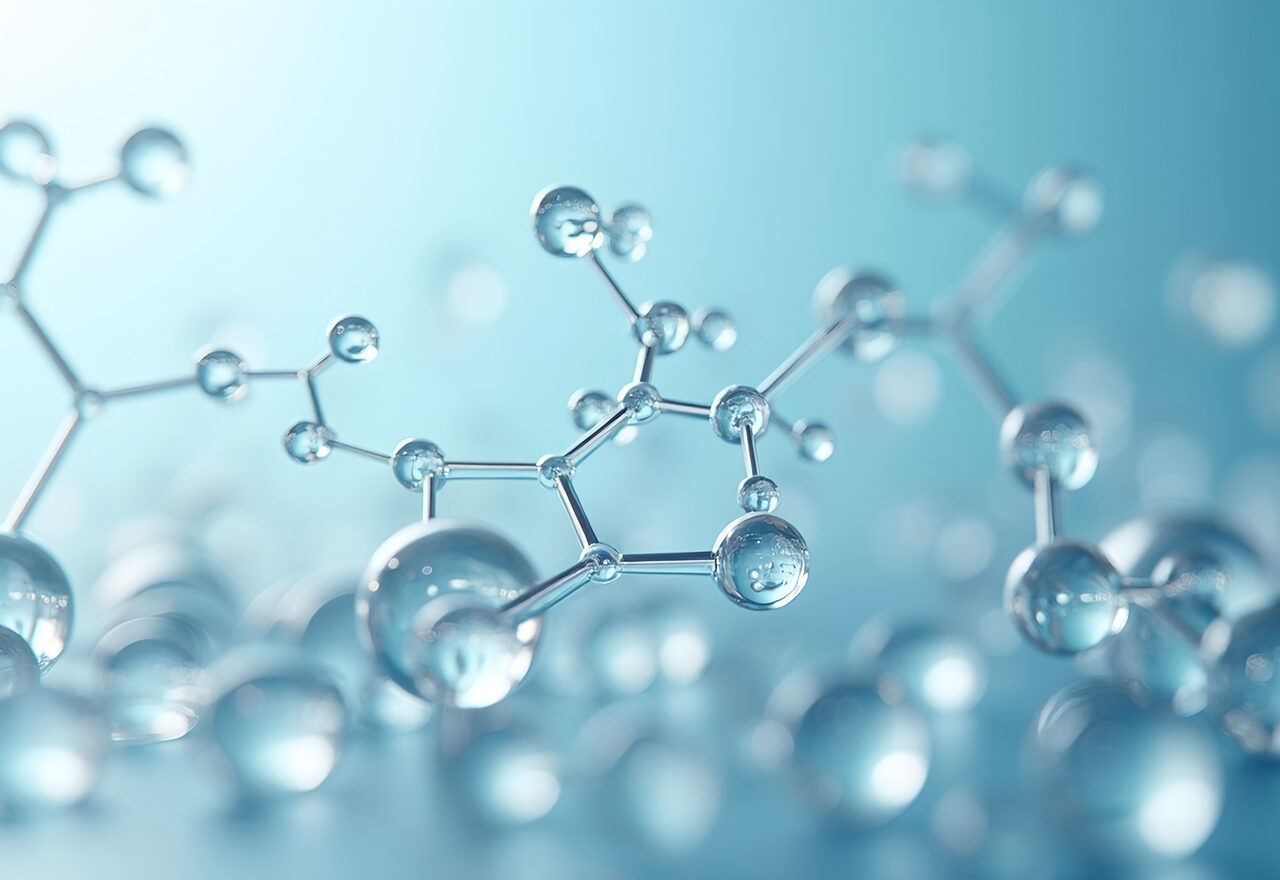[Disclaimer: This article is for informational purposes only and should not be considered a substitute for medical advice.]
Research peptides represent one of the most dynamic and promising areas in modern scientific investigation. These small but powerful chains of amino acids serve as essential tools for understanding biological processes and developing new therapeutic approaches.
While naturally occurring peptides have long fascinated scientists, synthetic research peptides have emerged as crucial instruments in laboratories worldwide. They offer unprecedented opportunities to study disease mechanisms and potential treatments.
As technology advances and research methods become more sophisticated, peptides continue to reveal new possibilities in medical research and biotechnology. This comprehensive guide examines the fundamental aspects of research peptides, their applications, and their significance in scientific discovery.
Key Takeaways
- Research peptides are synthetic molecules used in laboratories to study biological processes and develop potential new treatments.
- Unlike therapeutic peptides which are approved for medical use, research peptides are strictly for laboratory experiments and scientific studies.
- These compounds help scientists understand disease mechanisms, test new drugs, and explore biological processes under controlled conditions.
- Safety protocols and ethical guidelines strictly govern the use of research peptides in laboratory settings.
What Are Peptides?
Peptides are short chains of amino acids linked by peptide bonds, serving as fundamental components of proteins1. They play important roles in various biological processes and have significant applications in pharmaceutical research, biotechnology, and the food industry.
Research Peptides vs. Therapeutic Peptides
| Characteristic | Research Peptides | Therapeutic Peptides |
| Primary Purpose | Laboratory research and experimental studies to investigate biological mechanisms | Treatment of specific medical conditions in human patients |
| Regulatory Status | Not approved for human use; laboratory research only | FDA-approved or equivalent regulatory clearance for clinical use |
| Purity Standards | Research-grade quality (>95-99% purity) with standard documentation | Pharmaceutical-grade quality (>98-99% purity) with extensive documentation and GMP compliance |
| Application Setting | Controlled laboratory environments only | Clinical settings under medical supervision |
| Intellectual Property | May be used to generate IP for future therapeutics | Protected by patents and regulatory exclusivity |
Research peptides are synthetic peptide molecules designed for scientific studies. Unlike therapeutic peptides, which are approved for medical use, research peptides are strictly intended for laboratory experiments.
Their primary purpose is to explore biological processes and evaluate potential applications in medicine, often serving as a precursor to drug development.
These peptides are typically produced in laboratories using chemical synthesis methods, allowing precise control over their structure and properties. This synthetic nature enables researchers to study their interactions in controlled environments, such as in vitro (outside the body) or in preclinical models.
Therapeutic peptides, on the other hand, are developed for clinical use to treat diseases. While both types share structural similarities, therapeutic peptides undergo rigorous testing and regulatory approval before reaching patients.
Research peptides remain confined to experimental settings, where they help scientists uncover mechanisms of action, test hypotheses, and identify candidates for future pharmaceutical development.
The growing interest in research peptides stems from their versatility and potential to address unmet medical needs. They play a critical role in advancing fields like molecular biology, biochemistry, and pharmacology by enabling precise studies of cell signaling, receptor interactions, and protein functions.
Third-Party Tested, 99% Purity
Order lab-verified peptides from our top recommended vendor.

How Are Research Peptides Made?
Research peptides are created through chemical synthesis, allowing scientists to design and produce specific amino acid sequences. Two main methods dominate this field: solid-phase peptide synthesis (SPPS) and liquid-phase peptide synthesis (LPPS)2.
SPPS is the preferred method in most laboratories. This technique builds peptides step by step on a solid resin, which simplifies purification and ensures precision. While less common, LPPS is valuable for producing longer or more complex peptides.
Quality control is crucial in peptide production. Scientists use sophisticated techniques like high-performance liquid chromatography (HPLC) and mass spectrometry to verify purity and composition. Even minor impurities can significantly affect experimental outcomes.
Several challenges exist in manufacturing:
- Long peptide sequences often face incomplete reactions or misfolding issues.
- Maintaining consistency across different batches requires precise control.
- Environmental conditions like temperature and humidity must be carefully monitored.
Despite these challenges, advancing technology continues to improve the reliability and efficiency of peptide synthesis. These improvements help researchers produce higher quality peptides for their studies.

Structure and Function of Peptides
Peptides are chains of amino acids linked together by peptide bonds. These bonds form between the carboxyl group of one amino acid and the amino group of another, creating the basic building blocks of proteins.
The structure of a peptide determines its function in biological systems. The sequence of amino acids creates unique shapes and properties:
- Primary structure refers to the specific order of amino acids.
- Secondary structure describes common patterns like helices and sheets.
- Tertiary structure shows how the chain folds into its final 3D shape.
Natural peptides in the body serve as hormones, neurotransmitters, and signaling molecules. For example, insulin is a peptide hormone that regulates blood sugar, while endorphins are peptides that manage pain and mood.
Synthetic research peptides mimic these natural structures but can be modified to study specific biological processes. Scientists can alter amino acid sequences to create peptides with enhanced stability or different functional properties.
Common Uses of Research Peptides
Research peptides serve as valuable tools in drug development and preclinical studies. Scientists use them to test potential therapeutic approaches before moving forward with clinical trials.
These molecules are particularly useful for studying cell signaling pathways. By observing how cells respond to specific peptides, researchers can better understand communication between cells and how diseases disrupt normal signaling.
In disease research, peptides help scientists model various conditions:
- Cancer researchers use peptides to study tumor growth and potential treatments.
- Neuroscience labs employ them to investigate brain cell communication and potential therapies for cognitive disorders.
- Metabolic disease studies utilize peptides to understand hormone regulation and energy metabolism.
Peptides also help researchers study protein-protein interactions. These studies are crucial for understanding disease mechanisms and identifying new drug targets.
Are Research Peptides Safe? Ethical Considerations
Research peptides must be handled with strict safety protocols in laboratory settings. This includes proper protective equipment, controlled storage conditions, and detailed documentation of all experimental procedures.
Institutional guidelines govern the use of research peptides in scientific studies. All research must receive approval from ethics committees and follow established safety protocols. Researchers must demonstrate proper training and understanding of potential risks before working with these compounds.
Safety in the laboratory extends beyond basic handling. Proper storage conditions prevent degradation, while detailed record-keeping ensures traceability. Regular safety audits help maintain compliance with institutional and regulatory requirements.
The misuse of research peptides raises serious ethical concerns. These compounds are designed exclusively for laboratory research, yet their unauthorized use for performance enhancement or anti-aging has become a concerning trend.
Responsible research requires a commitment to ethical principles. Scientists must balance the potential benefits of peptide research against safety considerations. This includes secure storage, careful documentation, and clear communication about the distinction between research and therapeutic applications.
Key Types of Research Peptides
Research laboratories commonly work with several important categories of peptides, each serving specific research purposes.
Cyclic Peptides
Cyclic peptides are known for their high affinity and selectivity in binding to protein targets. They are characterized by their cyclic structure, which enhances stability and resistance to degradation. Cyclic peptides have been isolated from various natural sources and are used as research tools and therapeutics, such as oxytocin and vasopressin3.
Bioactive Peptides
Bioactive peptides are protein fragments with health benefits, including antimicrobial, antihypertensive, and antioxidant properties. They can be derived from natural sources through enzymatic hydrolysis or synthesized chemically4.
Antimicrobial Peptides (AMPs)
AMPs are small peptides that form part of the innate immune system and exhibit broad-spectrum antimicrobial activity against bacteria, fungi, parasites, and viruses. They are increasingly important due to rising antibiotic resistance and have applications in medicine, agriculture, and food safety5.
Short Bioactive Peptides
Short peptides are involved in various biological functions and have therapeutic applications. They include cell-penetrating peptides, tumor-homing peptides, and peptide hormones. These peptides are crucial in developing biomaterials and novel biofunctional materials for medical applications6.
Growth Hormone-Releasing Peptides (GHRPs)
GHRPs are used in research on growth hormone deficiencies, anti-aging therapies, and muscle-wasting conditions. They also show promise in cardioprotection, reducing inflammation, and mitigating fibrosis in various tissues7.
How Do Researchers Study Peptides?
Scientists use various sophisticated techniques to understand how peptides interact with biological systems.
Mass spectrometry allows researchers to analyze peptide structure and purity with exceptional precision. This technique helps verify the exact composition of synthetic peptides and track their behavior in experiments.
NMR spectroscopy provides detailed information about peptide structure and movement. This powerful tool helps scientists understand how peptides change shape when interacting with other molecules. X-ray crystallography offers another view, creating detailed 3D images of peptide structures.
Animal models and cell cultures provide controlled environments for studying peptide effects. Researchers can observe how peptides influence cellular behavior, metabolism, and signaling pathways. These studies help bridge the gap between laboratory findings and potential therapeutic applications.
Modern technology is transforming peptide research. Artificial intelligence now helps predict peptide structures and interactions, speeding up the discovery process. These computational tools allow researchers to design more effective peptides for specific research purposes.
The Legal and Regulatory Landscape
Bioactive peptides, derived from food proteins, are subject to various regulatory frameworks across different countries. These frameworks are designed to protect consumers from risks and misleading claims.
A critical aspect of regulatory approval for these peptides is the requirement for substantial evidence from human studies to support health claims, as data from in-vitro and animal studies alone are insufficient. The market for bioactive peptides is growing, driven by consumer awareness of their health benefits, necessitating robust regulatory policies to manage their approval and market release8.
Regulatory challenges exist in peptide drug development. Current guidelines don’t fully address the unique properties of peptide-based drugs, particularly regarding drug-drug interactions.
This gap is significant because peptides are a heterogeneous class of molecules, and existing guidelines for small molecules and therapeutic proteins do not fully apply. Institutions and regulatory bodies like the FDA and EMA continue working to develop more specific frameworks for oversight of peptide therapeutics.
The Future of Research Peptides
Peptide therapeutics have gained significant momentum, with approximately 140 peptide drugs currently in clinical trials9. This resurgence is driven by their ability to address unmet medical needs and serve as alternatives to small molecules and biologics.
Recent technological advancements have significantly impacted peptide research. The integration of AI in peptide development has facilitated the design and discovery of novel peptides, enhancing the efficiency of drug discovery processes. Innovations in radiolabeling, particularly with 18F, have improved the potential of peptides in diagnostic imaging and targeted radiotherapy10.
Peptides are being explored for a wide range of applications, including antimicrobial, anticancer, and immunosuppressant therapies. Peptide-based vaccines are also under investigation for their potential in preventing infectious diseases and chronic conditions like cancer and Alzheimer’s disease.
The future of peptide research is bright, with ongoing advancements in technology and methodology driving the discovery and development of novel therapeutics. Continued research efforts are essential to address existing challenges and fully realize the potential of peptides in medicine.
References
- Tiwari, S., Rajan, N., & Dwivedi, U. (2021). A REVIEW ON CHEMISTRY OF PEPTIDES. .
↩︎ - Fields G. B. (2002). Introduction to peptide synthesis. Current protocols in protein science, Chapter 18, 18.1.1–18.1.9. https://doi.org/10.1002/0471140864.ps1801s26 ↩︎
- Deyle, K., Kong, X. D., & Heinis, C. (2017). Phage Selection of Cyclic Peptides for Application in Research and Drug Development. Accounts of chemical research, 50(8), 1866–1874. https://doi.org/10.1021/acs.accounts.7b00184 ↩︎
- Purohit, K., Reddy, N., & Sunna, A. (2024). Exploring the Potential of Bioactive Peptides: From Natural Sources to Therapeutics. International journal of molecular sciences, 25(3), 1391. https://doi.org/10.3390/ijms25031391 ↩︎
- Huan, Y., Kong, Q., Mou, H., & Yi, H. (2020). Antimicrobial Peptides: Classification, Design, Application and Research Progress in Multiple Fields. Frontiers in microbiology, 11, 582779. https://doi.org/10.3389/fmicb.2020.582779
↩︎ - Apostolopoulos, V., Bojarska, J., Chai, T. T., Elnagdy, S., Kaczmarek, K., Matsoukas, J., New, R., Parang, K., Lopez, O. P., Parhiz, H., Perera, C. O., Pickholz, M., Remko, M., Saviano, M., Skwarczynski, M., Tang, Y., Wolf, W. M., Yoshiya, T., Zabrocki, J., Zielenkiewicz, P., … Toth, I. (2021). A Global Review on Short Peptides: Frontiers and Perspectives. Molecules (Basel, Switzerland), 26(2), 430. https://doi.org/10.3390/molecules26020430 ↩︎
- Argente, J., García-Segura, L. M., Pozo, J., & Chowen, J. A. (1996). Growth hormone-releasing peptides: clinical and basic aspects. Hormone research, 46(4-5), 155–159. https://doi.org/10.1159/000185015
↩︎ - Chalamaiah, M., Ulug, S., Hong, H., & Wu, J. (2019). Regulatory requirements of bioactive peptides (protein hydrolysates) from food proteins. Journal of Functional Foods. https://doi.org/10.1016/J.JFF.2019.04.050.
↩︎ - Fosgerau, K., & Hoffmann, T. (2015). Peptide therapeutics: current status and future directions.. Drug discovery today, 20 1, 122-8 . https://doi.org/10.1016/j.drudis.2014.10.003. ↩︎
- Richter, S., & Wuest, F. (2014). 18F-Labeled Peptides: The Future Is Bright. Molecules, 19, 20536 – 20556. https://doi.org/10.3390/molecules191220536. ↩︎








